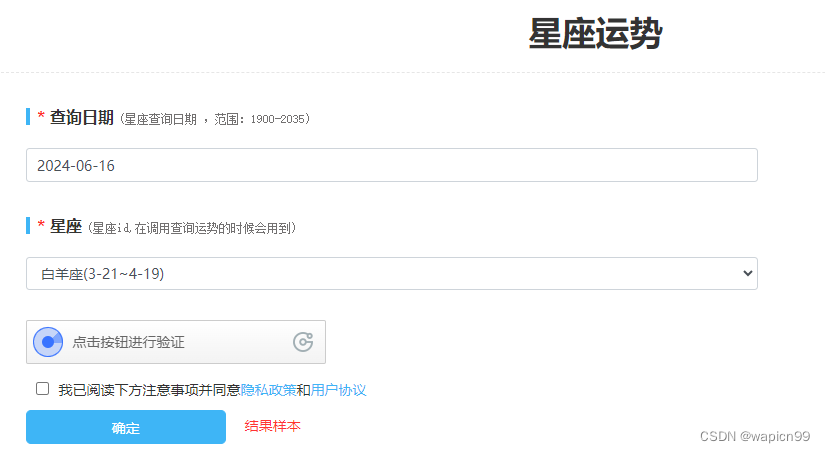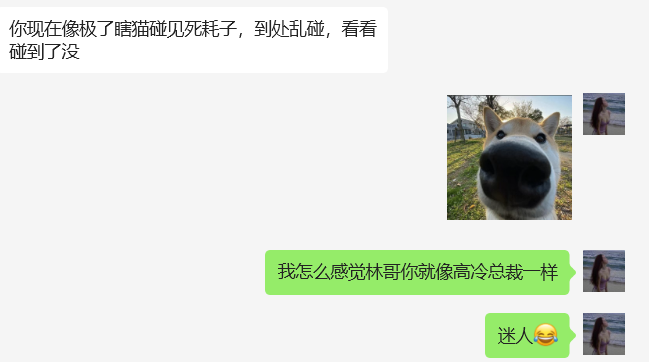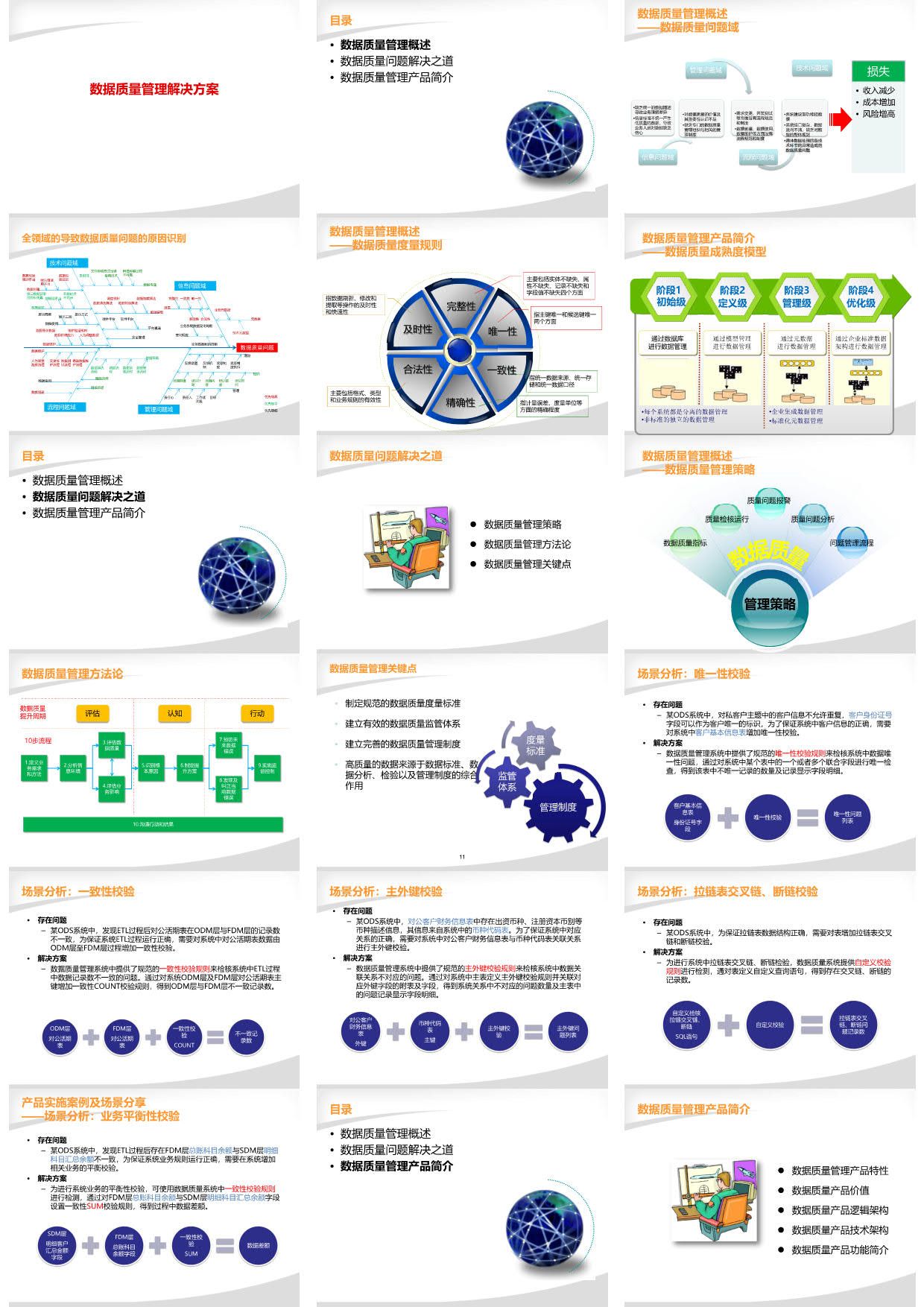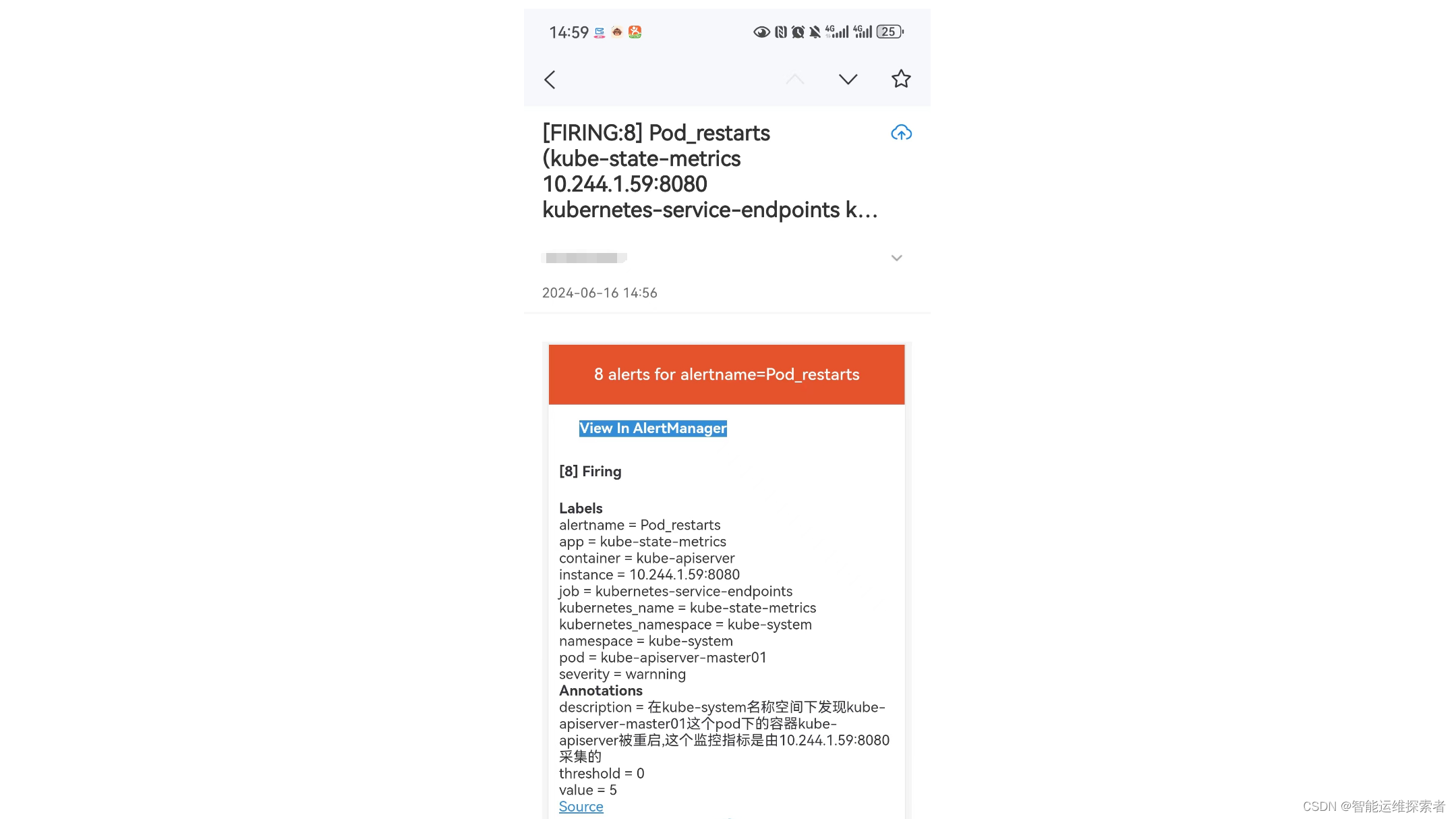卡尔曼滤波源码注释和调用示例
flyfish
Python版本代码地址
C++版代码地址
主要用于分析代码,增加了中文注释
import numpy as np
import scipy.linalg
"""
0.95分位数的卡方分布表,N自由度(包含N=1到9的值)。
取自MATLAB/Octave的chi2inv函数,用作Mahalanobis门限。
"""
chi2inv95 = {
1: 3.8415,
2: 5.9915,
3: 7.8147,
4: 9.4877,
5: 11.070,
6: 12.592,
7: 14.067,
8: 15.507,
9: 16.919
}
class KalmanFilter(object):
"""
一个用于图像空间中跟踪边界框的简单卡尔曼滤波器。
8维状态空间
x, y, a, h, vx, vy, va, vh
包含边界框中心位置 (x, y)、长宽比 a、高度 h 及其相应的速度。
对象运动遵循恒定速度模型。边界框位置 (x, y, a, h) 被作为状态空间的直接观测值(线性观测模型)。
"""
def __init__(self):
ndim, dt = 4, 1.
# 创建卡尔曼滤波器模型矩阵
self._motion_mat = np.eye(2 * ndim, 2 * ndim)
for i in range(ndim):
self._motion_mat[i, ndim + i] = dt
self._update_mat = np.eye(ndim, 2 * ndim)
# 运动和观测不确定性相对于当前状态估计进行选择。这些权重控制模型中的不确定性量。这有点hacky。
self._std_weight_position = 1. / 20
self._std_weight_velocity = 1. / 160
def initiate(self, measurement):
"""
从未关联的测量创建跟踪。
参数
----------
measurement : ndarray
边界框坐标 (x, y, a, h) 包含中心位置 (x, y)、长宽比 a 和高度 h。
返回值
-------
(ndarray, ndarray)
返回新跟踪的均值向量(8维)和协方差矩阵(8x8维)。
"""
mean_pos = measurement
mean_vel = np.zeros_like(mean_pos)
mean = np.r_[mean_pos, mean_vel]
std = [
2 * self._std_weight_position * measurement[3],
2 * self._std_weight_position * measurement[3],
1e-2,
2 * self._std_weight_position * measurement[3],
10 * self._std_weight_velocity * measurement[3],
10 * self._std_weight_velocity * measurement[3],
1e-5,
10 * self._std_weight_velocity * measurement[3]
]
covariance = np.diag(np.square(std))
return mean, covariance
def predict(self, mean, covariance):
"""
基于模型预测下一状态。
参数
----------
mean : ndarray
当前状态的均值向量(8维)。
covariance : ndarray
当前状态的协方差矩阵(8x8维)。
返回值
-------
(ndarray, ndarray)
返回预测的均值向量和协方差矩阵。
"""
std_pos = [
self._std_weight_position * mean[3],
self._std_weight_position * mean[3],
1e-2,
self._std_weight_position * mean[3]
]
std_vel = [
self._std_weight_velocity * mean[3],
self._std_weight_velocity * mean[3],
1e-5,
self._std_weight_velocity * mean[3]
]
motion_cov = np.diag(np.square(np.r_[std_pos, std_vel]))
mean = np.dot(self._motion_mat, mean)
covariance = np.linalg.multi_dot((self._motion_mat, covariance, self._motion_mat.T)) + motion_cov
return mean, covariance
def project(self, mean, covariance):
"""
将状态分布(均值和协方差)投影到观测空间。
参数
----------
mean : ndarray
状态分布的均值向量(8维)。
covariance : ndarray
状态分布的协方差矩阵(8x8维)。
返回值
-------
(ndarray, ndarray)
返回观测空间中的均值向量(4维)和协方差矩阵(4x4维)。
"""
std = [
self._std_weight_position * mean[3],
self._std_weight_position * mean[3],
1e-1,
self._std_weight_position * mean[3]
]
innovation_cov = np.diag(np.square(std))
mean = np.dot(self._update_mat, mean)
covariance = np.linalg.multi_dot((self._update_mat, covariance, self._update_mat.T))
return mean, covariance + innovation_cov
def update(self, mean, covariance, measurement):
"""
使用观测值更新状态分布。
参数
----------
mean : ndarray
先验状态分布的均值向量(8维)。
covariance : ndarray
先验状态分布的协方差矩阵(8x8维)。
measurement : ndarray
当前观测到的边界框坐标 (x, y, a, h)。
返回值
-------
(ndarray, ndarray)
更新后的状态分布的均值向量和协方差矩阵。
"""
projected_mean, projected_cov = self.project(mean, covariance)
chol_factor, lower = scipy.linalg.cho_factor(projected_cov, lower=True, check_finite=False)
kalman_gain = scipy.linalg.cho_solve((chol_factor, lower),
np.dot(covariance, self._update_mat.T).T, check_finite=False).T
innovation = measurement - projected_mean
new_mean = mean + np.dot(innovation, kalman_gain.T)
new_covariance = covariance - np.linalg.multi_dot((kalman_gain, projected_cov, kalman_gain.T))
return new_mean, new_covariance
def gating_distance(self, mean, covariance, measurements, only_position=False):
"""
计算状态分布和观测值之间的门限距离。
可从 `chi2inv95` 中获得合适的距离门限。如果 `only_position` 为 False,则卡方分布有4个自由度,否则为2个。
参数
----------
mean : ndarray
状态分布的均值向量(8维)。
covariance : ndarray
状态分布的协方差矩阵(8x8维)。
measurements : ndarray
N×4维矩阵,包含N个观测值,每个观测值的格式为 (x, y, a, h),其中 (x, y) 为边界框中心位置,a 为长宽比,h 为高度。
only_position : 可选[bool]
如果为True,距离计算仅针对边界框中心位置。
返回值
-------
ndarray
返回长度为N的数组,其中第i个元素包含 (mean, covariance) 和 `measurements[i]` 之间的平方Mahalanobis距离。
"""
mean, covariance = self.project(mean, covariance)
if only_position:
mean, covariance = mean[:2], covariance[:2, :2]
measurements = measurements[:, :2]
cholesky_factor = np.linalg.cholesky(covariance)
d = measurements - mean
z = scipy.linalg.solve_triangular(
cholesky_factor, d.T, lower=True, check_finite=False, overwrite_b=True)
squared_maha = np.sum(z * z, axis=0)
return squared_maha
调用示例1
import numpy as np
from kalman_filter_cn import KalmanFilter
class KalmanFilterTracker:
def __init__(self, initial_measurement):
self.kf = KalmanFilter()
self.mean, self.covariance = self.kf.initiate(initial_measurement)
self.history = [initial_measurement[:2]] # 只记录位置 (x, y)
def predict_and_update(self, measurement):
self.mean, self.covariance = self.kf.predict(self.mean, self.covariance)
self.mean, self.covariance = self.kf.update(self.mean, self.covariance, measurement)
self.history.append(self.mean[:2]) # 只记录位置 (x, y)
return self.mean, self.covariance
# 示例用法
initial_measurement = np.array([0, 0, 1, 1])
tracker = KalmanFilterTracker(initial_measurement)
measurements = [
np.array([1, 1, 1, 1]),
np.array([2, 2, 1, 1]),
np.array([3, 3, 1, 1]),
np.array([4, 4, 1, 1]),
np.array([5, 5, 1, 1])
]
for measurement in measurements:
tracker.predict_and_update(measurement)
print("History of positions:", tracker.history)
import matplotlib.pyplot as plt
from matplotlib.animation import FuncAnimation
def animate_kalman_filter(history):
fig, ax = plt.subplots()
ax.set_xlim(0, 6)
ax.set_ylim(0, 6)
line, = ax.plot([], [], 'bo-', label='Kalman Filter')
true_line, = ax.plot([], [], 'ro--', label='True Path')
def init():
line.set_data([], [])
true_line.set_data([], [])
return line, true_line
def update(frame):
x_data = [h[0] for h in history[:frame+1]]
y_data = [h[1] for h in history[:frame+1]]
line.set_data(x_data, y_data)
true_x = [i for i in range(len(history))]
true_y = [i for i in range(len(history))]
true_line.set_data(true_x, true_y)
return line, true_line
ani = FuncAnimation(fig, update, frames=len(history), init_func=init, blit=True, repeat=True)
ani.save('kalman_filter.gif', writer='imagemagick')
plt.legend()
plt.show()
animate_kalman_filter(tracker.history)

调用示例2
import numpy as np
import matplotlib.pyplot as plt
from matplotlib.animation import FuncAnimation
from kalman_filter_cn import KalmanFilter
from typing import Tuple
class KalmanFilterTracker:
def __init__(self, initial_measurement: np.ndarray) -> None:
self.kf = KalmanFilter()
self.mean, self.covariance = self.kf.initiate(initial_measurement)
self.history = [initial_measurement[:2]] # 只记录位置 (x, y)
def predict_and_update(self, measurement: np.ndarray) -> Tuple[np.ndarray, np.ndarray]:
self.mean, self.covariance = self.kf.predict(self.mean, self.covariance)
self.mean, self.covariance = self.kf.update(self.mean, self.covariance, measurement)
self.history.append(self.mean[:2]) # 只记录位置 (x, y)
return self.mean, self.covariance
class KalmanFilterAnimation:
def __init__(self, tracker: KalmanFilterTracker, measurements: np.ndarray) -> None:
self.tracker = tracker
self.measurements = measurements
def init(self):
self.line.set_data([], [])
self.true_line.set_data([], [])
return self.line, self.true_line
def update(self, frame):
x_data = [h[0] for h in self.tracker.history[:frame+1]]
y_data = [h[1] for h in self.tracker.history[:frame+1]]
self.line.set_data(x_data, y_data)
true_x = [m[0] for m in self.measurements[:frame+1]]
true_y = [m[1] for m in self.measurements[:frame+1]]
self.true_line.set_data(true_x, true_y)
return self.line, self.true_line
def animate(self) -> None:
fig, ax = plt.subplots()
ax.set_xlim(0, 10)
ax.set_ylim(-1.5, 1.5)
self.line, = ax.plot([], [], 'bo-', label='Kalman Filter')
self.true_line, = ax.plot([], [], 'ro--', label='True Path')
ani = FuncAnimation(fig, self.update, frames=len(self.tracker.history),
init_func=self.init, blit=True, repeat=True)
ani.save('kalman_filter_curve.gif', writer='imagemagick')
plt.legend()
plt.show()
# 初始化卡尔曼滤波器
initial_measurement = np.array([0, 0, 1, 1])
tracker = KalmanFilterTracker(initial_measurement)
# 生成测量值,形成曲线轨迹(正弦波)
measurements = []
for t in np.linspace(0, 10, 100):
x = t
y = np.sin(t)
measurements.append(np.array([x, y, 1, 1]))
# 更新卡尔曼滤波器
for measurement in measurements:
tracker.predict_and_update(measurement)
# 创建动画并生成GIF
animation = KalmanFilterAnimation(tracker, measurements)
animation.animate()
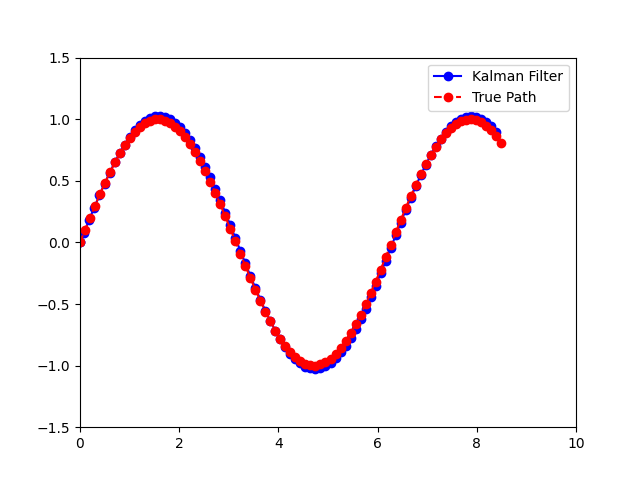
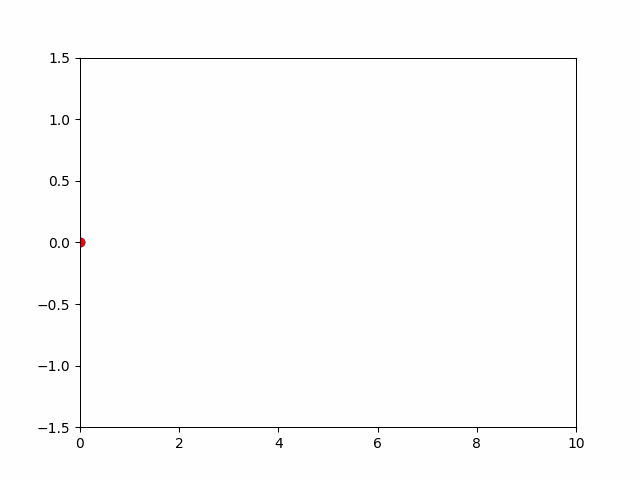
如果要分析滤波器性能、调试滤波器以及可视化滤波器是非常有用的,那么可以这样做
class KalmanFilterTracker:
def __init__(self, initial_measurement: np.ndarray) -> None:
self.kf = KalmanFilter()
self.mean, self.covariance = self.kf.initiate(initial_measurement)
self.history = [initial_measurement[:2]] # 只记录位置 (x, y)
self.states = [self.mean] # 存储历史状态均值
self.covariances = [self.covariance] # 存储历史协方差矩阵
def predict_and_update(self, measurement: np.ndarray) -> Tuple[np.ndarray, np.ndarray]:
self.mean, self.covariance = self.kf.predict(self.mean, self.covariance)
self.mean, self.covariance = self.kf.update(self.mean, self.covariance, measurement)
self.history.append(self.mean[:2]) # 只记录位置 (x, y)
self.states.append(self.mean) # 存储历史状态均值
self.covariances.append(self.covariance) # 存储历史协方差矩阵
return self.mean, self.covariance
记录历史值可以分析滤波器的性能,查找和修正可能的问题。对于可视化和演示目的,存储历史值可以让绘制出估计轨迹和实际轨迹,以便直观地比较和展示滤波效果。
如果只是单纯的用,在递归估计中,只需保持前一时刻的状态即可
class KalmanFilterTracker:
def __init__(self, initial_measurement: np.ndarray) -> None:
self.kf = KalmanFilter()
self.mean, self.covariance = self.kf.initiate(initial_measurement)
def predict_and_update(self, measurement: np.ndarray) -> Tuple[np.ndarray, np.ndarray]:
self.mean, self.covariance = self.kf.predict(self.mean, self.covariance)
self.mean, self.covariance = self.kf.update(self.mean, self.covariance, measurement)
return self.mean, self.covariance


